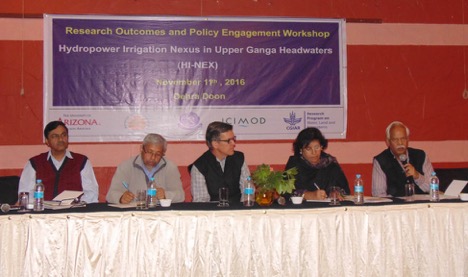
On 11 November 2016, international researchers and policy-makers came together to discuss the research results and draft policy recommendations of the Irrigation-Hydropower Nexus in the Upper Ganges Headwaters (HI-NEX) project. The research team has spent the past two years investigating the impact of hydropower development on irrigation and livelihoods, hydro-climatic risk of glacial lake formation, ecosystem services, and benefits sharing in the Himalayan region of northern India.
The state of Uttarakhand, in India’s Himalayas, is positioned to help meet the rising energy needs of northern India due to its high hydropower potential. Hydropower potential in mountain tributaries is increasingly being harnessed by a growing number of small, in-river hydropower projects. Although their individual capacities are not large, small hydropower projects can impact local water availability and livelihoods in nearby mountain communities.
The meeting, held in Dehra Dun, India, began with a welcome and summary of the project’s findings and policy recommendations by Dr. Christopher Scott from the University of Arizona. Key issues were presented and discussed as follows:
- Local-government administrators can be enlisted to ensure that hydropower as an economic development investment benefits local communities in addition to urban centres (Mr. A.K. Das, former Chief Secretary of the Government of Uttarakhand).
- Existing policies for small hydropower development in the state have gained value-addition of HI-NEX research (Mr. V. Tyagi, Chief Project Officer of the Uttarakhand Renewable Energy Development Agency – UREDA).
- Research findings of projects such as HI-NEX must be based on fieldwork:
- The Bhilangana Basin, an upper Ganges tributary, forms an important learning opportunity (chaired by Dr. Piyoosh Rautela, of the State Disaster Mitigation and Management Centre).
- Downstream infrastructure and communities face risks of glacial fragmentation and hydroclimatic extreme events (Dr. Suraj Mal, Shaheed Bhagat Singh College, University of Delhi).
- Hydropower developers, local communities, and stakeholders have diverging perspectives on benefits sharing. Nepal’s hydropower development experience has much to offer and to learn from Indian Himalayan states (Ms. Rashmi Shrestha, International Centre for Integrated Mountain Development – ICIMOD, Nepal).
- Livelihoods and irrigation impacts of small hydropower development can be significant and will require renewed attention to assessments of environmental and social impacts (Dr. Debashish Sen, People’s Science Institute, Dehra Dun).

The presentations were followed by a panel discussion on hydropower policies in Uttarakhand, chaired by Dr. Sara Ahmed (Gender and Water Expert, and member of the IWSN External Advisory Board). An interactive question and answer period was facilitated by Dr. Ravi Chopra (former director of the People’s Science Institute and advisor to the HI-NEX project). The meeting engaged senior state officials and subject matter experts in discussion about how to minimize irrigation trade-offs of hydropower development in Uttarakhand and develop policies to enhance equitable benefits among local residents and villages within the state as well as between Uttarakhand and neighboring states including New Delhi, with rampant growth in electricity demand combined with deteriorating air quality related in part to emissions from thermal power plants. Non-governmental organizations, local social movements, and university researchers all participated in the interactive discussions. The meeting provided an invaluable forum for policy makers and research experts to interact and collaborate on developing and implementing local policy goals in a shared learning environment.
The meeting was the culmination of a two-year collaborative research project, led by the University of Arizona (Tucson, USA), with the participation of People’s Science Institute (Dehra Dun, India), Shaheed Bhagat Singh College, University of Delhi (India), and the International Centre for Integrated Mountain Development (ICIMOD, Kathmandu, Nepal). Support was provided by CGIAR’s Research Program on Water, Land and Ecosystems with supplementary funding for student research provided by the International Water Security Network, and ICIMOD’s own core funding.
Press coverage of the meeting can be found here, here, here and here.
